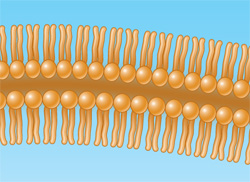recap
3.4 recap
Lipids include both hydrophobic and amphipathic molecules that are largely composed of carbon and hydrogen. They are important in energy storage, light absorption, intercellular communication, and biological structures. A phospholipid is composed of two hydrophobic fatty acids linked to glycerol and a hydrophilic phosphate group. Cell membranes contain phospholipid bilayers.
learning outcomes
You should be able to:
Compare and contrast triglycerides in fats and oils.
Describe how the polar and nonpolar natures of phospholipids result in the formation of a membrane bilayer.
Explain why carotenoids, steroids, certain vitamins, and waxes are classified as lipids.
1.
If phospholipids were placed in a nonpolar solvent, would a membrane-
The phospholipids would aggregate, with the polar heads facing in and the tails facing out—
2.
What is the difference between fats and oils?
Fats are solid at room temperature and have single bonds (saturated) between fatty acid carbon atoms (saturated). Oils are liquid at room temperature and have double bonds between some fatty acid carbon atoms (unsaturated). 
3.
Why are steroids and some vitamins classified as lipids?
Steroids and some vitamins are classified as lipids because they are composed largely of carbon atoms linked together with substituent hydrogen atoms and are insoluble in water and soluble in nonpolar solvents.
In this chapter we discussed three of the classes of macromolecules that are characteristic of living organisms. All organisms are made up of these three types of macromolecules, a fact that shows the wonderful biochemical unity of life. This unity in turns implies that all life has a common origin (see Key Concept 1.1). Essential to this origin was a fourth class of macromolecule, the nucleic acids. In the next chapter we will turn to the related topics of nucleic acids and the origin of life.